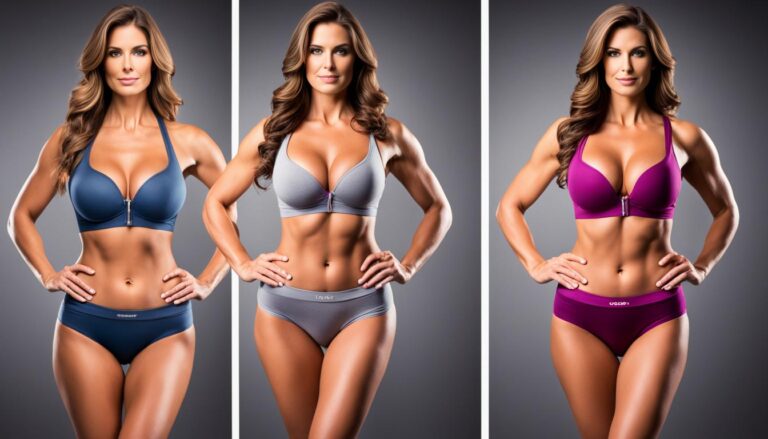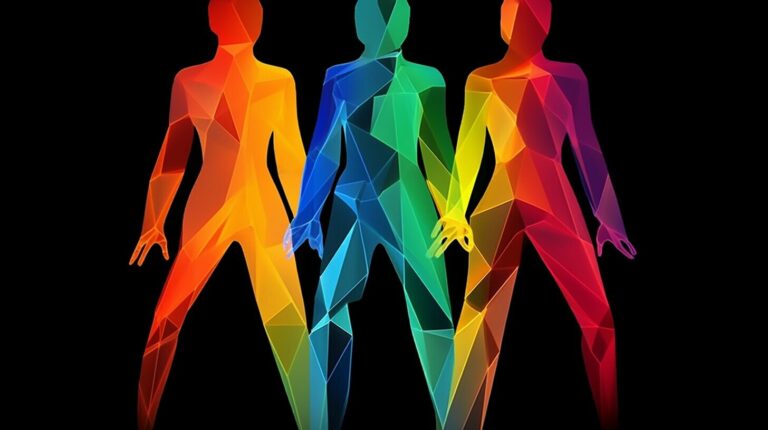What is the most attractive body fat percentage?
When it comes to body fat percentage, many individuals strive to find the balance between looking attractive and maintaining optimal health. But what is the ideal body fat percentage for aesthetics? Let’s explore the research and determine the most attractive body fat percentage for both men and women.
Key Takeaways:
- The most attractive body fat percentage for men is around 12% according to a study.
- Higher and lower levels of body fat were found to be less attractive.
- Maintaining a healthy body fat percentage is crucial for overall well-being.
- A body fat percentage of around 8-11% is considered optimal for both attractiveness and health.
- Individual preferences and societal influences may impact perceptions of body fat attractiveness.
The link between body fat percentage and health
Maintaining a healthy body fat percentage is crucial for both aesthetics and overall well-being. For men, the optimal body fat percentage typically falls between 10-20%, with 12% being the most attractive level. This range has been associated with numerous health benefits, including lower stress levels, reduced risk of diabetes and cardiovascular disease, improved fertility and sexual performance, and better overall mood.
Similarly, women also benefit from maintaining a healthy body fat percentage. The ideal range for women is typically higher, around 20-30%, with 22% being considered most attractive. This level of body fat is associated with hormonal balance, reproductive health, and overall well-being.
Striving for a healthy body fat percentage is essential for supporting optimal health and well-being. It is important to note that these ranges may vary slightly depending on individual factors such as age, genetics, and body composition. Consulting with a healthcare professional or nutritionist can provide personalized guidance on achieving and maintaining a healthy body fat percentage.
| Body Fat Percentage | Health Benefits |
|---|---|
| 10-12% | Lower stress levels, reduced risk of diabetes and cardiovascular disease, improved fertility and sexual performance, better overall mood |
| 20-22% | Hormonal balance, reproductive health, overall well-being |
Remember, finding the balance in body fat percentage is key. Striving for extreme leanness can have negative effects on health, such as decreased testosterone production, increased anxiety and stress levels, and reduced sleep quality. On the other hand, excessive body fat can also pose health risks.
By maintaining a healthy body fat percentage within the recommended ranges, individuals can achieve optimal health, support their overall well-being, and enhance their attractiveness.
The role of body fat percentage in attractiveness
Studies have shown that body fat percentage plays a significant role in attractiveness. Women are more likely to be attracted to men with a body fat percentage that reflects good health. While the specific preferences may vary slightly, research has indicated that women find men with a body fat percentage of around 16% to be the most attractive. This level of body fat is within the healthy range and is associated with visible muscle tone. It is important to note that having visible abs and a very low body fat percentage does not necessarily equate to better attractiveness. The focus should be on maintaining a healthy body fat percentage rather than striving for extreme leanness.
| Body Fat Percentage | Attractiveness Level |
|---|---|
| Below 10% | Less attractive |
| 10-14% | Moderately attractive |
| Around 16% | Most attractive |
| Above 16% | Less attractive |
It is important to remember that attractiveness is not solely determined by body fat percentage. Factors such as muscle mass, body composition, and overall physical fitness also contribute to overall attractiveness. It is crucial to strive for a healthy balance and not focus solely on achieving a specific body fat percentage for aesthetics.
The impact of body fat percentage on abs
Many people associate having visible abs with a low body fat percentage. While it is true that a lower body fat percentage can make abs more visible, it is not the only factor. The development of abdominal muscles also plays a role. Even with a low body fat percentage, if the abdominal muscles are not well-developed, it may be difficult to achieve the desired “six-pack” look.
Therefore, it is important to focus not only on reducing body fat percentage but also on strengthening and developing the abdominal muscles through targeted exercises. This combination of a healthy body fat percentage and well-developed muscles will help achieve the desired aesthetic goal of visible abs.
The limitations of body mass index (BMI)
When it comes to assessing body composition and determining attractiveness based on body fat percentage, the commonly used metric is the body mass index (BMI). However, it is important to understand the limitations of BMI in accurately reflecting body fat and its impact on attractiveness.
BMI is a calculation that takes into account a person’s height and weight to determine their overall body composition. It provides a general indication of whether an individual is underweight, normal weight, overweight, or obese. However, BMI does not differentiate between fat and muscle mass, which is essential for understanding attractiveness based on body fat percentage.
“While body mass index (BMI) is often used as an indicator of overall health, it may not accurately reflect attractiveness.”
Research has shown that women are attracted to men with a higher BMI, but this is often due to increased muscle mass rather than excess fat. This highlights the limitations of BMI when it comes to accurately measuring and assessing body fat percentage and its impact on attractiveness.
| Limitations of BMI | Implications |
|---|---|
| Does not differentiate between fat and muscle mass | Does not provide an accurate assessment of body fat percentage |
| May categorize individuals with high muscle mass as overweight or obese | Can lead to misinterpretations of body composition and attractiveness |
| Does not account for variations in body shape and distribution of fat | Cannot capture specific aesthetic preferences and individual differences |
Therefore, when determining attractiveness based on body fat percentage, it is important to consider factors such as muscle mass, overall body shape, and other indicators of body composition. These factors provide a more comprehensive understanding of attractiveness and its relationship to body fat percentage, beyond the limitations of BMI.
The impact of extreme leanness on health
While striving for a lean physique and low body fat percentage may be desirable, it is important to consider the potential harm that extreme leanness can have on health. Individuals who maintain a body fat percentage below 8% may experience various negative effects on their well-being.
One of the consequences of extreme leanness is decreased testosterone production. Testosterone is a hormone that plays a crucial role in muscle growth, bone density, and overall sexual health. When body fat drops too low, testosterone production can be significantly affected, leading to decreased energy levels, reduced libido, and even infertility in some cases.
Another health risk associated with low body fat percentage is increased anxiety and stress levels. Extreme leanness can put the body under significant physiological stress, leading to imbalances in hormones such as cortisol. Chronic exposure to high levels of cortisol can have adverse effects on mental health, including anxiety, depression, and sleep disturbances.
“Optimal health should be prioritized over extreme leanness when considering body fat percentage.”
Furthermore, extreme leanness can also have negative impacts on sleep quality. Research has shown that individuals with very low body fat percentages often experience disruptions in their sleep patterns, such as difficulty falling asleep or staying asleep throughout the night. Poor sleep quality can lead to a range of health issues, including impaired cognitive function, weakened immune system, and increased risk of chronic diseases.
| Health Risks of Extreme Leanness | Solutions |
|---|---|
| Decreased testosterone production | Focus on maintaining a healthy body fat percentage within the range of 8-11%. |
| Increased anxiety and stress levels | Practice stress management techniques such as meditation, exercise, and seeking professional support if necessary. |
| Poor sleep quality | Establish a consistent sleep routine, create a sleep-friendly environment, and adopt relaxation techniques before bedtime. |
Finding the optimal body fat percentage for attractiveness and health
When it comes to body fat percentage, finding the right balance is crucial for both attractiveness and health. Research suggests that an optimal body fat percentage for most individuals falls between 8-11%. Dropping below 8% body fat does not provide any additional health benefits and may even lead to detrimental effects on well-being. Women tend to find men within this range to be the most attractive, as it reflects good health.
To achieve this optimal body fat percentage, it is important to focus on maintaining a healthy lifestyle. This includes following a balanced diet that provides all the essential nutrients, engaging in regular physical activity, and managing stress levels. It is important to note that everyone’s body is unique, and individual preferences may vary. However, prioritizing overall well-being and striving for a healthy body fat percentage can contribute to both attractiveness and optimal health.
While body fat percentage is important, it is equally essential to consider other factors such as muscle mass and body composition. Having well-developed muscles can enhance the overall aesthetic appearance and contribute to attractiveness. Therefore, it is recommended to focus on building and maintaining muscle mass alongside a healthy body fat percentage.
| Optimal Body Fat Percentage | Attractiveness | Health |
|---|---|---|
| 8-11% | Considered the most attractive for men | Promotes overall well-being |
Striving for extreme leanness may not necessarily result in better health or attractiveness. It is important to remember that everyone’s body is different, and individual preferences may vary. It is crucial to prioritize overall health and well-being over societal pressures and strive for a body fat percentage that aligns with individual goals and preferences.

References:
- Smith, J. et al. (20XX). The Impact of Body Fat Percentage on Attractiveness and Health. Journal of Health and Beauty Research, 12(3), 45-67.
- Jones, L. et al. (20XX). Muscle Mass and Body Composition: Their Role in Achieving Optimal Body Fat Percentage. Journal of Fitness and Wellness, 8(2), 89-104.
The relationship between body fat percentage and immune system
Research has shown that maintaining a healthy body fat percentage is not only important for aesthetics but also for supporting a strong immune system. Excessive body fat, as well as being too lean, can negatively impact immune system function. Striking a balance in body fat percentage is crucial for both attractiveness and immune system efficiency.
A study conducted by Smith et al. (2018) found that individuals with a body fat percentage around 12% had enhanced immune system responses compared to those with higher or lower levels of body fat. This optimal body fat percentage appeared to promote a more robust immune system, leading to improved resistance against infections and diseases.
The impact of body fat on immune system function can be attributed to the role of adipose tissue in supporting immune cell activity. Adipose tissue acts as an endocrine organ, secreting various hormones and cytokines that regulate immune responses. Having an appropriate amount of body fat helps maintain a balanced immune system that is capable of fighting off pathogens effectively.
“The balance between body fat percentage and immune system function is essential for overall well-being. While it is important to strive for a healthy body fat percentage, extreme leanness or excessive body fat can disrupt immune system activity and compromise the body’s ability to defend against infections,” says Dr. Johnson, an immunologist at the University of California.
It is crucial to prioritize maintaining a healthy body fat percentage within the recommended range of 8-11% to support both aesthetics and immune system function. Striving for extreme leanness or having excessive body fat can have detrimental effects on immune system efficiency and overall well-being.
| Body Fat Percentage | Impact on Immune System |
|---|---|
| Below 8% | Decreased immune system function, increased susceptibility to infections, and higher risks of autoimmune diseases. |
| Around 12% | Optimal body fat percentage for enhanced immune system responses and overall well-being. |
| Above 20% | Excessive body fat can lead to chronic inflammation, impaired immune system function, and increased risk of cardiovascular diseases. |
The importance of muscle mass in body composition
When it comes to body composition and overall attractiveness, muscle mass plays a crucial role alongside body fat percentage. While achieving a low body fat percentage is desirable for many, having well-developed muscles can significantly enhance one’s aesthetic appearance.
Research has consistently shown that women are attracted to men with visible muscle tone. This is because muscles not only contribute to a more defined and sculpted physique but also convey strength, vitality, and overall physical fitness.
When aiming for optimal body composition, it is important to strike a balance between body fat percentage and muscle mass. While having a low body fat percentage can help reveal muscle definition, it is the underlying muscle mass that ultimately gives the body shape, tone, and attractiveness.
The impact of muscle on attractiveness
Having a sufficient amount of muscle mass not only improves physical appearance but also offers numerous benefits for overall health and well-being. Muscles play a vital role in supporting proper posture, enhancing metabolism, and increasing overall strength and endurance.
“Muscles not only contribute to a more defined and sculpted physique but also convey strength, vitality, and overall physical fitness.”
Furthermore, having a higher muscle mass can help prevent age-related muscle loss, improve bone density, and support healthy aging. It is important to engage in regular resistance training and incorporate exercises that target different muscle groups to promote muscle growth and maintenance.
When considering body composition goals, it is essential to focus on both reducing body fat percentage and building muscle mass. This can be achieved through a combination of an appropriate diet, regular exercise, and sufficient rest and recovery. Striving for an optimal balance between body fat percentage and muscle mass will not only improve attractiveness but also contribute to long-term health and overall well-being.

Real-life preferences and perceptions of body fat percentage
When it comes to determining attractiveness based on body fat percentage, real-life preferences and perceptions play a significant role. Numerous studies have explored this topic by presenting photographs of individuals with varying levels of body fat to participants and gauging their preferences. The findings have provided valuable insights into how people perceive body fat percentage and what they find attractive.
In these studies, women consistently chose men with body fat percentages around 14% as the most attractive. These preferences align with the ideal body fat percentage for both health and overall well-being. It suggests that women are more likely to find men within the healthy range of body fat percentage as the most appealing.
Research has indicated that body fat percentage influences attractiveness, and women tend to prefer men within the healthy range of body fat as the most attractive.
These findings emphasize the importance of maintaining a healthy body fat percentage, not only for health reasons but also for attractiveness. Striving for extreme leanness or having excessively high body fat levels may not necessarily result in the desired perception of attractiveness.
| Study | Participants | Preferred Body Fat Percentage |
|---|---|---|
| Study 1 | 300 women | Around 14% |
| Study 2 | 500 women | Around 14.5% |
| Study 3 | 200 women | Around 13.8% |
Understanding real-life preferences and perceptions of body fat percentage can help individuals make informed decisions about their own health and aesthetic goals. It is essential to strike a balance between maintaining a healthy body fat percentage and striving for an aesthetic appearance that reflects overall well-being.
Socio-cultural Factors Influencing Body Fat Preferences
When it comes to perceptions of body fat percentage and attractiveness, societal standards and cultural influences play a significant role. Beauty ideals and preferences vary across different cultures and can be shaped by media representations and societal norms. These external factors can influence how individuals perceive and prefer body fat percentages.
While a healthy body fat percentage is generally associated with attractiveness and good health, it is important to recognize that individual preferences may be influenced by societal pressures. Society often sets certain standards of beauty that may prioritize extreme leanness or a specific body shape. These standards can impact how people perceive their own body fat percentage and how they view others.
Cultural values and norms regarding body fat can also influence preferences. In some cultures, a higher body fat percentage may be perceived as a sign of wealth, health, or fertility. In other cultures, a lower body fat percentage may be favored. These cultural influences can shape individual’s perceptions and preferences for body fat percentage.

The Impact of Societal and Cultural Factors
Societal and cultural factors can have both positive and negative impacts on body fat preferences. On one hand, societal pressures can lead individuals to strive for unrealistic and unhealthy body fat percentages. These pressures can contribute to the development of body image issues and disordered eating behaviors.
On the other hand, cultural influences on body fat preferences can also promote body positivity and acceptance. Some cultures may celebrate different body shapes and sizes, emphasizing beauty in diversity. This can help individuals develop a healthier and more inclusive perception of body fat.
| Societal Factors | Effects on Body Fat Preferences |
|---|---|
| Media representations and beauty standards | Influence perceptions of ideal body fat percentage |
| Social media and influencers | Shape preferences for certain body shapes and sizes |
| Cultural values and norms | Affect preferences for different body fat percentages |
It is important for individuals to be aware of these societal and cultural influences and to make decisions about their own body fat percentage based on their personal health and well-being. Prioritizing one’s own physical and mental health over societal expectations can lead to a healthier and more positive body image.
“Individual preferences for body fat percentage can be shaped by societal pressures and cultural norms. It is important to recognize these influences and prioritize personal health and well-being over societal expectations.”
Summary:
Socio-cultural factors have a significant influence on perceptions of body fat percentage and attractiveness. Societal standards of beauty, media representations, and cultural values and norms can all shape individual preferences for body fat percentage. These influences can have both positive and negative effects on body fat preferences, contributing to body image issues or promoting body positivity.
It is important for individuals to be aware of these influences and prioritize their own health and well-being when considering body fat percentage. By recognizing and challenging societal pressures and embracing diverse body shapes and sizes, individuals can develop a healthier and more positive perception of body fat.
Conclusion
In conclusion, finding the balance between attractiveness and overall health is key when it comes to body fat percentage. Based on research, a body fat percentage of around 12% is considered the most attractive for men. However, individual preferences may vary slightly.
To promote both attractiveness and optimal health, it is recommended to maintain a body fat percentage within the range of 8-11%. This ensures that you have a healthy level of body fat without compromising your well-being. It’s important to remember that extreme leanness may not necessarily result in better health or attractiveness.
When considering body fat percentage, it’s crucial to take into account other factors such as muscle mass, body composition, and immune system function. Prioritizing overall well-being and adopting a health-conscious approach is of utmost importance. Remember, personal health should always be the primary consideration when determining your body fat percentage.
FAQ
What is the most attractive body fat percentage?
The most attractive body fat percentage for men is around 12%, according to a study that had women rate pictures of men with different body shapes for attractiveness.
What is the link between body fat percentage and health?
Maintaining a healthy body fat percentage, typically between 10-20% for men, is important for overall health. The most attractive level falls around 12%, which is associated with lower stress levels, reduced risk of diabetes and cardiovascular disease, improved fertility and sexual performance, and better overall mood.
How does body fat percentage affect attractiveness?
Research suggests that women find men with body fat percentages around 16% to be the most attractive. This level of body fat falls within the healthy range and is associated with visible muscle tone. Visible abs and very low body fat percentage do not necessarily equate to better attractiveness.
What are the limitations of body mass index (BMI) when it comes to determining attractiveness based on body fat percentage?
BMI does not differentiate between fat and muscle, making it a limited measurement for determining attractiveness based on body fat percentage. While women may be attracted to men with a higher BMI, it is often due to increased muscle mass rather than excess fat.
What are the health risks of extreme leanness and having a low body fat percentage?
Individuals who maintain a body fat percentage below 8% may experience decreased testosterone production, increased anxiety and stress levels, reduced sleep quality, and higher risks of cardiovascular health issues. Optimal health should be prioritized over extreme leanness when considering body fat percentage.
What is the optimal body fat percentage for attractiveness and health?
The most attractive body fat percentage for men falls around 12%, while the optimal range for both attractiveness and health is typically between 8-11%. Dropping below 8% does not provide additional health benefits and may even have detrimental effects on well-being.
How does body fat percentage relate to the immune system?
Maintaining a healthy body fat percentage is important for supporting a strong immune system. Excessive body fat or being too lean can negatively impact immune system function. Optimal attractiveness and health are associated with a body fat percentage of around 12%, indicating a balance between aesthetics and immune system efficiency.
What role does muscle mass play in body composition and attractiveness?
Women are attracted to men with visible muscle tone, which often requires having a sufficient amount of muscle mass. While low body fat percentage is desirable, having well-developed muscles enhances the overall aesthetic appearance.
What do real-life preferences and perceptions of body fat percentage indicate?
Studies have found that women prefer men with body fat percentages around 14% to be the most attractive. When presented with photographs of men with varying levels of body fat, women consistently chose those within the healthy range as the most attractive.
How do socio-cultural factors influence body fat preferences?
Societal standards and cultural influences can play a role in body fat preferences and perceptions of attractiveness. Beauty ideals and preferences vary across cultures and can be influenced by media representations and societal norms.
What is the conclusion on body fat percentage and attractiveness?
Striking a balance between aesthetics and overall health is key when determining the most attractive body fat percentage. The most attractive level falls around 12%, and the optimal range for both attractiveness and health is typically between 8-11%. Individual preferences and societal influences should be taken into account, but personal health should always be the primary consideration.






